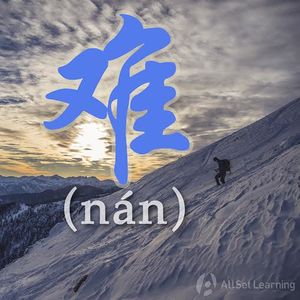Difference between revisions of "Expressing "difficult" with "nan""
(→Books) |
Jacobleeliu (talk | contribs) |
||
| Line 68: | Line 68: | ||
[[Category:A2 grammar points]] | [[Category:A2 grammar points]] | ||
| + | {{HSK|HSK3}} | ||
{{Used for|Describing actions}} | {{Used for|Describing actions}} | ||
{{Basic Grammar|难|A2|难 + Verb|<em>难</em> 做。<em>难</em> 买。|grammar point|ASG35T4H}} | {{Basic Grammar|难|A2|难 + Verb|<em>难</em> 做。<em>难</em> 买。|grammar point|ASG35T4H}} | ||
Latest revision as of 07:59, 10 April 2019
-
Level
-
Similar to
-
Used for
-
Keywords
难 (nán) is an adjective that means "difficult." When something is "hard to do" (as in difficult), the word 难 (nán) can be used before the verb.
Contents
难 (nán) with General Verbs
Just as 好 (hǎo) can be used to indicate that it's easy to do something, 难 (nán) can be attached to verbs (with a few special exceptions), to indicate that something is hard to do.
Structure
The structure is:
Subj. + (很) 难 + Verb
Examples
- 这 句 话 很 难 懂。 This sentence is hard to understand.
- 汉语 很 难 学。Mandarin is hard to learn.
- 中国菜 很 难 做。Chinese food is hard to make.
- 这 个 东西 现在 很 难 买。This thing is really difficult to purchase now.
- 这 个 汉字 很 难 写。This character is very difficult to write.
难 (nán) with Sense Verbs
难 (nán) can also be attached to "sense verbs" (e.g. look, taste, smell, etc.) to indicate that something offers a "bad sensory experience."
Structure
The structure is:
Subj. + (很) 难 + [Sense Verb]
Examples
- 你 做 的 菜 很 难吃。The dishes you cook taste bad.
- 这里 的 咖啡 很 难喝。The coffee here tastes bad.
- 这 首 歌 很 难听。This song is terrible (hard to listen to).
- 这 种 花 很 难闻。This kind of flower smells bad.
- 这 件 衣服 很 难看吗?Is this article of clothing ugly?
Warning! If you're trying to say that a particular dish is "difficult to eat," don't use 难吃 (nánchī)! The word 难吃 (nánchī) only means "bad-tasting" and not "difficult to eat."



